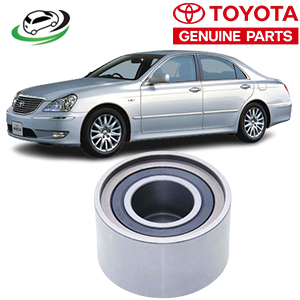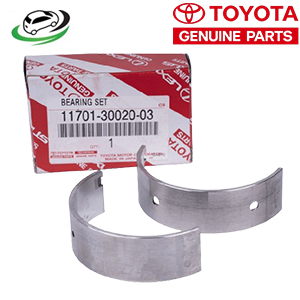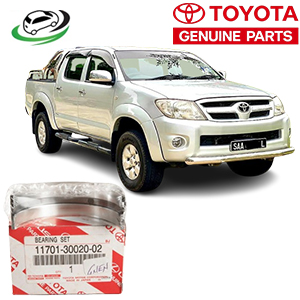-14%
Get Toyota Hilux Vigo 06 Genuine Crankshaft Bearing Shells 11701-30020-02
Crankshaft bearing shells are vital components in the internal combustion engine, playing a crucial role in the smooth and efficient operation of a vehicle’s engine. Often referred to as main bearings or rod bearings, crankshaft bearing shells are positioned between the crankshaft and the engine block or connecting rods. These bearings facilitate the rotation of the crankshaft, reduce friction, and support the loads generated by the reciprocating motion of the pistons.
Genuine crankshaft bearing shells, specifically those manufactured by Original Equipment Manufacturers (OEMs) or authorized suppliers, are designed to meet the strict tolerances and performance requirements of specific engines. In this detailed explanation, we will cover the function, types, materials, benefits, signs of wear, maintenance tips, and replacement process for genuine crankshaft bearing shells.
Function of Crankshaft Bearing Shells
The primary function of crankshaft bearing shells is to reduce friction between the crankshaft and the engine block or connecting rods. These bearings support the rotational movement of the crankshaft, ensuring that the pistons’ up-and-down motion translates into smooth and efficient rotary motion.
Key functions include:
- Reducing Friction: Crankshaft bearing shells create a low-friction surface that allows the crankshaft to rotate freely, reducing energy loss and preventing excessive heat buildup. A thin layer of oil between the bearing surface and the crankshaft journal further reduces friction.
- Supporting Loads: During the combustion cycle, significant forces are exerted on the crankshaft by the pistons. The bearing shells absorb and distribute these forces, preventing damage to the crankshaft or engine block.
- Maintaining Proper Alignment: Crankshaft bearing shells ensure that the crankshaft remains properly aligned within the engine block, preventing misalignment that could lead to engine damage or failure.
- Minimizing Wear: Genuine crankshaft bearing shells are designed to provide a durable surface that minimizes wear on both the bearings and the crankshaft journals, extending the lifespan of the engine.
Types of Crankshaft Bearing Shells
Crankshaft bearing shells are typically categorized into two main types: main bearings and rod bearings.
- Main Bearings:
- Location: Main bearings are positioned between the crankshaft and the engine block. They support the rotational motion of the crankshaft and keep it aligned within the engine block.
- Function: Main bearings handle the bulk of the load generated by the reciprocating motion of the pistons. They provide a smooth surface for the crankshaft to rotate while maintaining its position in the engine block.
- Composition: Main bearings usually consist of two half-shells: an upper and lower half. These shells are installed in the main bearing journals of the engine block and held in place by bearing caps.
- Rod Bearings:
- Location: Rod bearings are located between the connecting rods and the crankshaft’s rod journals. Each connecting rod has a bearing shell on both ends where it attaches to the crankshaft.
- Function: Rod bearings support the connecting rod as it rotates with the crankshaft, allowing the pistons to move up and down while converting that motion into rotary motion. These bearings experience high loads during the combustion process and are designed to withstand the stresses of engine operation.
- Composition: Like main bearings, rod bearings consist of two half-shells that surround the crankshaft journal and are held in place by the connecting rod caps.
Materials Used in Genuine Crankshaft Bearing Shells
Genuine crankshaft bearing shells are made from materials that provide an optimal balance of durability, strength, and friction reduction. These materials are carefully chosen to withstand the extreme conditions within an engine, including high temperatures, pressures, and loads. The most common materials used for genuine bearing shells include:
- Tri-Metal Bearings:
- Composition: Tri-metal bearings are made from three layers: a steel backing layer, a copper-lead intermediate layer, and a soft overlay of tin or lead alloy. This combination provides excellent wear resistance, load capacity, and heat dissipation.
- Advantages: Tri-metal bearings offer high fatigue resistance and can accommodate slight misalignments between the crankshaft and the engine block. They are commonly used in high-performance engines due to their ability to withstand heavy loads.
- Bi-Metal Bearings:
- Composition: Bi-metal bearings consist of a steel backing layer and an aluminum or copper alloy overlay. These bearings are lighter and provide excellent friction reduction, making them suitable for modern engines with tighter tolerances.
- Advantages: Bi-metal bearings offer improved heat dissipation and are less prone to corrosion. They are often used in fuel-efficient, low-emission engines where friction reduction is a priority.
- Steel-Backed Bearings:
- Composition: Steel-backed bearings have a steel backing with a thin layer of an anti-friction material such as babbitt or aluminum alloy. The steel backing provides strength and rigidity, while the overlay reduces friction.
- Advantages: These bearings are durable and can handle high loads, making them suitable for heavy-duty applications such as commercial vehicles or performance engines.
Benefits of Using Genuine Crankshaft Bearing Shells
Opting for genuine crankshaft bearing shells ensures that the engine components meet the exact specifications and tolerances required for optimal performance. The benefits of using genuine parts include:
- Precise Fitment: Genuine crankshaft bearing shells are manufactured to exact tolerances specified by the engine manufacturer. This ensures a precise fit, which is critical for maintaining proper oil clearance and preventing excessive wear.
- Superior Materials: OEM bearing shells are made from high-quality materials that offer excellent wear resistance, load capacity, and heat dissipation. Using inferior aftermarket bearings can result in premature wear or failure.
- Longevity: Genuine bearing shells are designed to last the life of the engine when properly maintained. They undergo rigorous testing to ensure they can withstand the stresses of engine operation.
- Warranty Protection: Using genuine parts often ensures that the vehicle’s warranty remains intact. Aftermarket parts may void the manufacturer’s warranty, leading to costly repairs.
- Engine Performance: Crankshaft bearing shells play a critical role in maintaining engine efficiency and performance. Genuine parts ensure that the engine operates as intended, providing smooth, reliable power delivery.
Signs of Worn Crankshaft Bearing Shells
Over time, crankshaft bearing shells can wear out due to the stresses of engine operation, poor lubrication, or contamination of the oil. It is essential to recognize the signs of worn bearings to prevent engine damage. Common symptoms include:
- Engine Knock or Rattle: One of the most common signs of worn crankshaft bearings is a knocking or rattling noise from the engine. This sound is often more pronounced when the engine is cold or under load.
- Low Oil Pressure: Worn bearings can cause oil pressure to drop, as the oil clearance between the bearing and crankshaft increases. A persistent low oil pressure warning should be addressed immediately.
- Metal Shavings in Oil: If the bearing shells are excessively worn, metal particles may appear in the engine oil. These shavings can be seen during an oil change or found on the oil filter.
- Excessive Vibration: Worn crankshaft bearings may cause the crankshaft to wobble or vibrate, leading to noticeable vibrations in the engine.
- Poor Engine Performance: As the bearing clearance increases, engine performance may suffer. Symptoms can include reduced power, poor acceleration, and rough idling.
Maintenance Tips for Crankshaft Bearing Shells
To ensure the longevity of crankshaft bearing shells, proper maintenance is essential. Here are some tips:
- Regular Oil Changes: Engine oil lubricates the bearings and reduces friction. Regular oil changes with high-quality oil prevent contamination and ensure that the bearings receive adequate lubrication.
- Use Quality Oil Filters: A good oil filter will trap contaminants and prevent them from circulating in the engine. This helps protect the bearing surfaces from abrasive particles.
- Monitor Oil Pressure: Keep an eye on the oil pressure gauge or warning light. Low oil pressure can indicate insufficient lubrication, which can lead to bearing wear.
- Avoid Overheating: High engine temperatures can break down oil and reduce its lubricating properties. Avoid driving the vehicle when it is overheating to prevent bearing damage.
- Perform Regular Engine Inspections: During routine maintenance, inspect the engine for any signs of bearing wear, such as unusual noises or metal shavings in the oil.
Replacement Process for Crankshaft Bearing Shells
Replacing crankshaft bearing shells requires disassembling part of the engine. Here’s an overview of the process:
- Disassemble the Engine: Begin by removing the engine’s oil pan to access the crankshaft. Depending on the vehicle, you may need to remove other components such as the timing belt or chain.
- Inspect the Crankshaft: Before replacing the bearings, inspect the crankshaft journals for any signs of wear or damage. If the journals are worn, they may need to be machined or replaced.
- Remove the Old Bearings: Carefully remove the bearing caps and take out the old bearing shells. Make sure to note the position of each bearing to ensure proper reassembly.
- Install the New Bearings: Clean the bearing surfaces and install the new bearing shells. Apply a thin layer of assembly lubricant to the bearing surface to ensure smooth operation during startup.
- Reassemble the Engine: Reinstall the bearing caps and torque them to the manufacturer’s specifications. Reassemble the rest of the engine components and refill the oil.
Conclusion
Genuine crankshaft bearing shells are essential for the smooth and efficient operation of an engine. These components reduce friction, support loads, and ensure proper alignment of the crankshaft. Opting for OEM parts guarantees precise fitment, superior materials, and long-lasting performance. Regular maintenance, including oil changes and inspections, is key to extending the life of these critical engine components and ensuring optimal engine performance.
Follow us on Facebook for more parts.






Reviews
Clear filtersThere are no reviews yet.